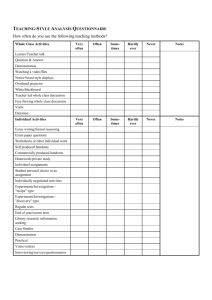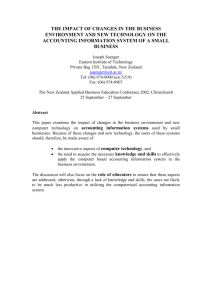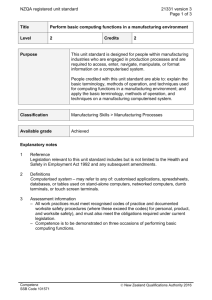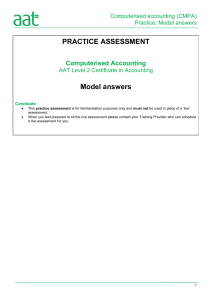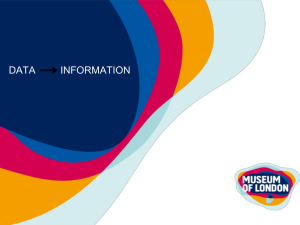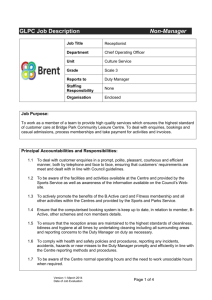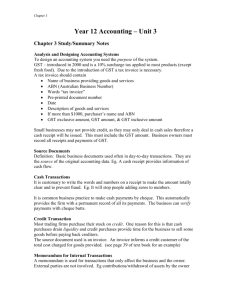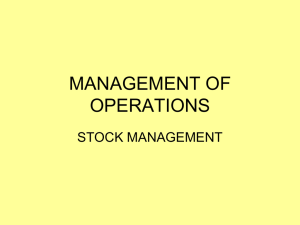CHAP 13 Q.I. Define a computerised accounting system. Distinguish
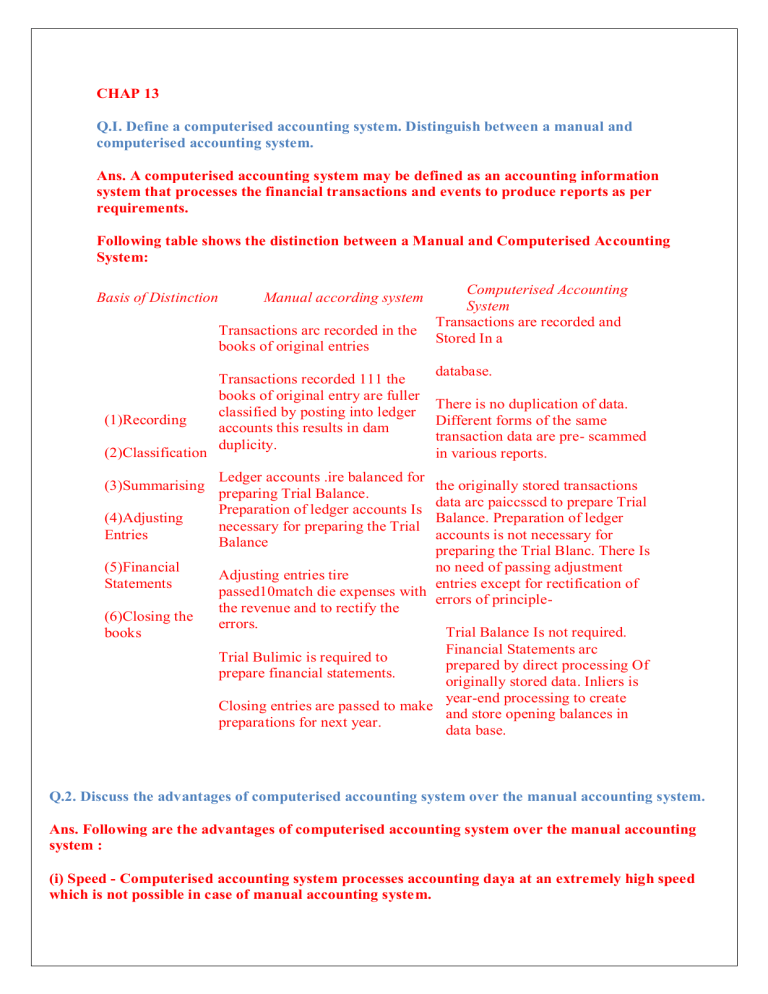
CHAP 13
Q.I. Define a computerised accounting system. Distinguish between a manual and computerised accounting system.
Ans. A computerised accounting system may be defined as an accounting information system that processes the financial transactions and events to produce reports as per requirements.
Following table shows the distinction between a Manual and Computerised Accounting
System:
Basis of Distinction Manual according system
Transactions arc recorded in the books of original entries
Computerised Accounting
System
Transactions are recorded and
Stored In a database.
(1)Recording
(2)Classification
Transactions recorded 111 the books of original entry are fuller classified by posting into ledger accounts this results in dam duplicity.
There is no duplication of data.
Different forms of the same transaction data are pre- scammed in various reports.
(3)Summarising
(4)Adjusting
Entries
(5)Financial
Statements
(6)Closing the books
Ledger accounts .ire balanced for preparing Trial Balance.
Preparation of ledger accounts Is necessary for preparing the Trial
Balance
Adjusting entries tire passed10match die expenses with the revenue and to rectify the errors. the originally stored transactions data arc paiccsscd to prepare Trial
Balance. Preparation of ledger accounts is not necessary for preparing the Trial Blanc. There Is no need of passing adjustment entries except for rectification of errors of principle-
Trial Bulimic is required to prepare financial statements.
Closing entries are passed to make preparations for next year.
Trial Balance Is not required.
Financial Statements arc prepared by direct processing Of originally stored data. Inliers is year-end processing to create and store opening balances in data base.
Q.2. Discuss the advantages of computerised accounting system over the manual accounting system.
Ans. Following are the advantages of computerised accounting system over the manual accounting system :
(i) Speed - Computerised accounting system processes accounting daya at an extremely high speed which is not possible in case of manual accounting system.
(ii) Accuracy and Reliability Since computerised accounting system uses computers. records arc
Considered more accurate and reliable. The possibility of error is eliminated because primary accounting data is entered once for all Manual accounting system is prone lo various types of errors because human beings are immune to tiredness. boredom and fatigue.
(iii) Up-to-date Information — The accounting records in a computerised accounting system arc updated automatically as and when accounting data is entered and stored. We get latest information pertaining to accounts
(iv) Real Time User Interface — Most of the computerised accounting systems are linked to other information system through a network of computers. This facilitates the availability of information to various users at the same time.
(v) Motivation and Employees Interest Computerised accounting system is maintained by a spccinliscd and trained staff. Employees are highly motivated. Computerised accounting system motivates the employees to develop their interest.
(vi) Storage and Retrieval— Computerised accounting system' can store large volumes of data. Same data can be utilized again and again. It permits fast and accurate retrieval of data
(vii) Automated Document Production A computer is an automatic machine. Computerised accounting system has standardised user defined format of accounting reports that are uncrated automatically. As a result. we get neat and clean records in a standardised format.
(viii) Management Information System Reports Computerised accounting system facilitates the production of various types of management information reports which help the management to run and control the business effectively.
Q.3. Describe the various types or accounting software Alongwith their advantages and limitations.
Ans. Following arc the various types of accounting software
(i) Ready to use (ii) Customised (iii) Tailored
(1) Ready to Use — Ready to use accounting software means standardised accounting software available in the market.
Following arc the advantages of ready to use software :
(a) Cost of installation is very low
(b) It is relatively easier lo learn.
(c) Its adaptability is very high.
(2) Training needs are simple and the vendor offers the training on the software free. • Following arc the limitations of ready to use software
(a) It is suitable for organisations running small/conventional business where the frequency or volume of accounting transactions is very low.
(b) This level of secrecy is low .
(c) It is prone in data frauds.
(d) It offers little scope of linking to other infomvioq systems
(ii) Customized-- accounting software meets the special requirements of the user. Following are the advantages of customised software :
(a)It is suited to large. medium business
(b)Secrecy of data and software can be maintained.
(c)It can be linked to the other information systems.
(d) Its adaptability is relatively high. Following are the limitations of customized software
(i) Its cost of installation and maintenance is relatively high.
(h)It requires well-trained staff. Training costs are very high.
Tailored Software Tailored software is designed to meet the specific requirement of the users. It forms an important pan of the organisational MIS.
Following arc the advantages of the tailored software
(a) Its level of secrecy is very high.
(b) It has unlimited number of users and their interface.
(c) It offers high flexibility in terms of number of users Following are the limitations of the tailored software
(d) Its cost of installation and maintenance is very high.
(e) Its training requirements are very high.
Q.-4. 'Accounting software is an integral part of the computerised accounting system1. Explain.
Briefly list the generic considerations before sourcing an accounting software.
Ans. It is rightly said that accounting software Is an integral pan of the computerised accounting system. An accounting software is a set of programmes which is used to work with hardware.
Software is a coded set of instructions stored in the form of circuits. The need for accounting software arises in the following two situations:
(i) When the computerised accounting system is introduced to replace the manual accounting system.
(ii) When the current computerised accounting System is replaced with n new one. Following arc the generic considerations before sourcing an accounting software .
(i) Cost of Installation and Maintenance Software should nor be costly in terms of its benefits Cost of maintenance should also be considered along with cost of installation
(ii) Flexibility — An accounting software should be flexible to meet the changing requirements of the users. The user should be able to run the software on variety of platforms and machines.
(iii) Size of Organisation — Small organisations. where the number of accounting transactions is not so large. may have simple i.e.. ready to use software A Ingra organisation with multi-user and geographically scattered locations will opt for a sophisticated software.
(iv) Adaptation and Training Needs — Some accounting software arc simple and their training requirements are low. On the other hand. some accounting software are sophisticated and complex and require Intensive training on a continuous basis.
(v) Utilities/MIS Reports — The choice of software also depends on the degree to which MIS reports arc used in the organisation.
(vi) Secrecy — Another consideration is the expected level of secrecy i.e.. security features which prevent unauthorised persons from accessing and manipulating data
Q.5. 'Computerised Accounting Systems arc best form of accounting system.' Do you agree ?
Comment.
Ans. Computerised accounting systems are considered best form of accounting system due to following advantages over manual system of accounting :
(i) Speed
(ii) Accuracy
(iii) Reliability
(iv) Lutes and up-to-date information
(v) Real-time user interface
(vi) Automated Document production
(vii) Scalability
(viii) Legibility
(ix) Efficiency
(x) Quality reports
(xi) Storage and retrieval
(xii) Employees' interest
Following are the limitations or disadvantages;
(i) Huge training cost
(ii) Resistance from the existing staff
(iii) System failure due to viruses
(iv) Breach of security
(v) ill -effects on health
In spite of these limitations. computerised accounting system is preferred to manual accounting system because its advantages outweigh its disadvantages
